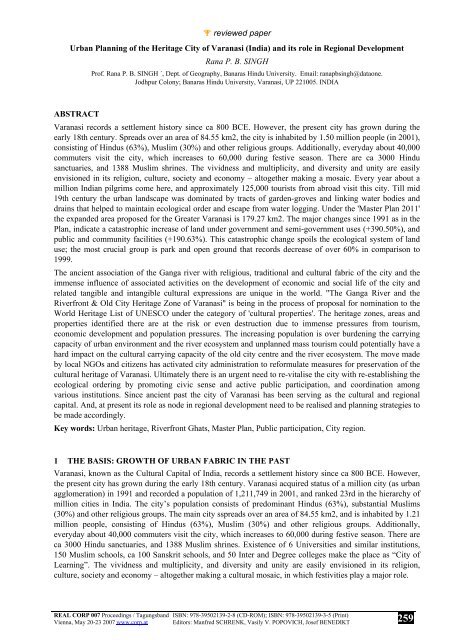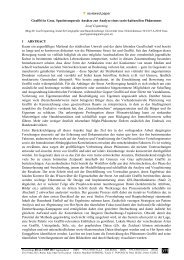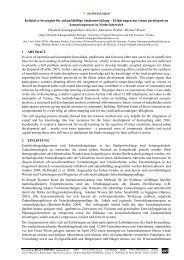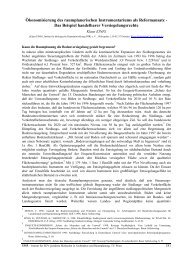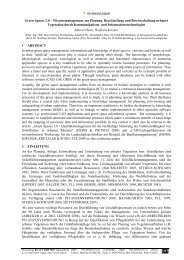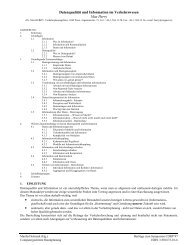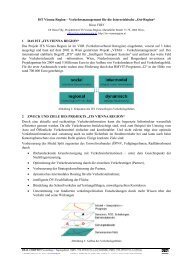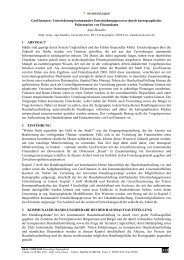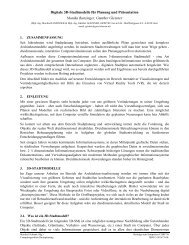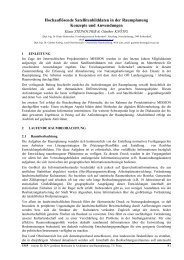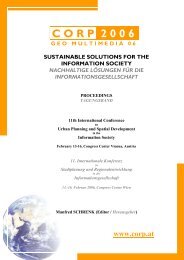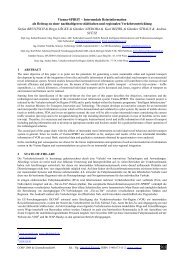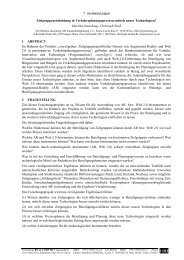reviewed paper Urban Planning of the Heritage City of Varanasi ...
reviewed paper Urban Planning of the Heritage City of Varanasi ...
reviewed paper Urban Planning of the Heritage City of Varanasi ...
Create successful ePaper yourself
Turn your PDF publications into a flip-book with our unique Google optimized e-Paper software.
REAL CORP 007 Proceedings / Tagungsband<br />
Vienna, May 20-23 2007 www.corp.at<br />
<strong>reviewed</strong> <strong>paper</strong><br />
<strong>Urban</strong> <strong>Planning</strong> <strong>of</strong> <strong>the</strong> <strong>Heritage</strong> <strong>City</strong> <strong>of</strong> <strong>Varanasi</strong> (India) and its role in Regional Development<br />
Rana P. B. SINGH<br />
Pr<strong>of</strong>. Rana P. B. SINGH ´, Dept. <strong>of</strong> Geography, Banaras Hindu University. Email: ranapbsingh@dataone.<br />
Jodhpur Colony; Banaras Hindu University, <strong>Varanasi</strong>, UP 221005. INDIA<br />
ABSTRACT<br />
<strong>Varanasi</strong> records a settlement history since ca 800 BCE. However, <strong>the</strong> present city has grown during <strong>the</strong><br />
early 18th century. Spreads over an area <strong>of</strong> 84.55 km2, <strong>the</strong> city is inhabited by 1.50 million people (in 2001),<br />
consisting <strong>of</strong> Hindus (63%), Muslim (30%) and o<strong>the</strong>r religious groups. Additionally, everyday about 40,000<br />
commuters visit <strong>the</strong> city, which increases to 60,000 during festive season. There are ca 3000 Hindu<br />
sanctuaries, and 1388 Muslim shrines. The vividness and multiplicity, and diversity and unity are easily<br />
envisioned in its religion, culture, society and economy – altoge<strong>the</strong>r making a mosaic. Every year about a<br />
million Indian pilgrims come here, and approximately 125,000 tourists from abroad visit this city. Till mid<br />
19th century <strong>the</strong> urban landscape was dominated by tracts <strong>of</strong> garden-groves and linking water bodies and<br />
drains that helped to maintain ecological order and escape from water logging. Under <strong>the</strong> 'Master Plan 2011'<br />
<strong>the</strong> expanded area proposed for <strong>the</strong> Greater <strong>Varanasi</strong> is 179.27 km2. The major changes since 1991 as in <strong>the</strong><br />
Plan, indicate a catastrophic increase <strong>of</strong> land under government and semi-government uses (+390.50%), and<br />
public and community facilities (+190.63%). This catastrophic change spoils <strong>the</strong> ecological system <strong>of</strong> land<br />
use; <strong>the</strong> most crucial group is park and open ground that records decrease <strong>of</strong> over 60% in comparison to<br />
1999.<br />
The ancient association <strong>of</strong> <strong>the</strong> Ganga river with religious, traditional and cultural fabric <strong>of</strong> <strong>the</strong> city and <strong>the</strong><br />
immense influence <strong>of</strong> associated activities on <strong>the</strong> development <strong>of</strong> economic and social life <strong>of</strong> <strong>the</strong> city and<br />
related tangible and intangible cultural expressions are unique in <strong>the</strong> world. "The Ganga River and <strong>the</strong><br />
Riverfront & Old <strong>City</strong> <strong>Heritage</strong> Zone <strong>of</strong> <strong>Varanasi</strong>" is being in <strong>the</strong> process <strong>of</strong> proposal for nomination to <strong>the</strong><br />
World <strong>Heritage</strong> List <strong>of</strong> UNESCO under <strong>the</strong> category <strong>of</strong> 'cultural properties'. The heritage zones, areas and<br />
properties identified <strong>the</strong>re are at <strong>the</strong> risk or even destruction due to immense pressures from tourism,<br />
economic development and population pressures. The increasing population is over burdening <strong>the</strong> carrying<br />
capacity <strong>of</strong> urban environment and <strong>the</strong> river ecosystem and unplanned mass tourism could potentially have a<br />
hard impact on <strong>the</strong> cultural carrying capacity <strong>of</strong> <strong>the</strong> old city centre and <strong>the</strong> river ecosystem. The move made<br />
by local NGOs and citizens has activated city administration to reformulate measures for preservation <strong>of</strong> <strong>the</strong><br />
cultural heritage <strong>of</strong> <strong>Varanasi</strong>. Ultimately <strong>the</strong>re is an urgent need to re-vitalise <strong>the</strong> city with re-establishing <strong>the</strong><br />
ecological ordering by promoting civic sense and active public participation, and coordination among<br />
various institutions. Since ancient past <strong>the</strong> city <strong>of</strong> <strong>Varanasi</strong> has been serving as <strong>the</strong> cultural and regional<br />
capital. And, at present its role as node in regional development need to be realised and planning strategies to<br />
be made accordingly.<br />
Key words: <strong>Urban</strong> heritage, Riverfront Ghats, Master Plan, Public participation, <strong>City</strong> region.<br />
1 THE BASIS: GROWTH OF URBAN FABRIC IN THE PAST<br />
<strong>Varanasi</strong>, known as <strong>the</strong> Cultural Capital <strong>of</strong> India, records a settlement history since ca 800 BCE. However,<br />
<strong>the</strong> present city has grown during <strong>the</strong> early 18th century. <strong>Varanasi</strong> acquired status <strong>of</strong> a million city (as urban<br />
agglomeration) in 1991 and recorded a population <strong>of</strong> 1,211,749 in 2001, and ranked 23rd in <strong>the</strong> hierarchy <strong>of</strong><br />
million cities in India. The city’s population consists <strong>of</strong> predominant Hindus (63%), substantial Muslims<br />
(30%) and o<strong>the</strong>r religious groups. The main city sspreads over an area <strong>of</strong> 84.55 km2, and is inhabited by 1.21<br />
million people, consisting <strong>of</strong> Hindus (63%), Muslim (30%) and o<strong>the</strong>r religious groups. Additionally,<br />
everyday about 40,000 commuters visit <strong>the</strong> city, which increases to 60,000 during festive season. There are<br />
ca 3000 Hindu sanctuaries, and 1388 Muslim shrines. Existence <strong>of</strong> 6 Universities and similar institutions,<br />
150 Muslim schools, ca 100 Sanskrit schools, and 50 Inter and Degree colleges make <strong>the</strong> place as “<strong>City</strong> <strong>of</strong><br />
Learning”. The vividness and multiplicity, and diversity and unity are easily envisioned in its religion,<br />
culture, society and economy – altoge<strong>the</strong>r making a cultural mosaic, in which festivities play a major role.<br />
ISBN: 978-39502139-2-8 (CD-ROM); ISBN: 978-39502139-3-5 (Print)<br />
Editors: Manfred SCHRENK, Vasily V. POPOVICH, Josef BENEDIKT<br />
259
<strong>Urban</strong> <strong>Planning</strong> <strong>of</strong> <strong>the</strong> <strong>Heritage</strong> <strong>City</strong> <strong>of</strong> <strong>Varanasi</strong> (India) and its role in Regional Development<br />
The impact <strong>of</strong> intense development pressures is harder in <strong>the</strong> old city centre where population density<br />
reaches to 500 to 700 persons/ha. Every year about half million Indian pilgrims/ devout Hindus comes here,<br />
and approximately 125,000 tourists from abroad visit this city. Till mid 19th century <strong>the</strong> urban landscape was<br />
dominated by tracts <strong>of</strong> garden-groves and linking water bodies and drains that helped to maintain ecological<br />
order and escape from water logging. Under <strong>the</strong> 'Master Plan 2011' <strong>the</strong> expanded area proposed for <strong>the</strong><br />
Greater <strong>Varanasi</strong> is 179.27 km2. The major changes since 1991 as in <strong>the</strong> Plan, indicate a catastrophic<br />
increase <strong>of</strong> land under government and semi-government uses (+390.50%), and public and community<br />
facilities (+190.63%). This catastrophic change spoils <strong>the</strong> ecological system <strong>of</strong> land use; <strong>the</strong> most crucial<br />
group is park and open ground that records decrease <strong>of</strong> over 60% in comparison to 1999.<br />
Kosambi (1970: 90) rightly remarks that “<strong>the</strong> first cities with full continuity into history lies on <strong>the</strong> river<br />
route, in spite <strong>of</strong> <strong>the</strong> difficulty <strong>of</strong> settling alluvial regions. …. Their foundation at <strong>the</strong> beginning <strong>of</strong> <strong>the</strong> first<br />
millennium can be explained only on <strong>the</strong> basis <strong>of</strong> still earlier navigation on <strong>the</strong>se powerful rivers that flowed<br />
swiftly through impenetrable forest and swamps”. In <strong>the</strong> similar way <strong>Varanasi</strong> might have grown, and after<br />
passage <strong>of</strong> time became <strong>the</strong> most famous sacred place <strong>of</strong> Hinduism. The archaeological findings at Rajghat<br />
(nor<strong>the</strong>rn part <strong>of</strong> Banaras city) confirm <strong>the</strong> existence <strong>of</strong> urban settlements during 800-500 BCE. Ashoka<br />
(272-242 BCE), <strong>the</strong> great Mauryan king, had declared Buddhism a state religion and visited Sarnath. Under<br />
his patronage <strong>the</strong>re developed a Buddhist township with many monasteries, stupas and shrines. The<br />
inscriptions <strong>of</strong> Kushana king Kanishka, dated 3rd century CE, refer to <strong>the</strong> persistence <strong>of</strong> Buddhism toge<strong>the</strong>r<br />
with animistic religion <strong>of</strong> Yaksha.<br />
The Pali and Buddhist literature mention <strong>the</strong> structure, condition and some plans <strong>of</strong> <strong>the</strong> city <strong>of</strong> <strong>Varanasi</strong>,<br />
especially narrating <strong>the</strong> six beautiful gates surrounding <strong>the</strong> city and moats along <strong>the</strong> main protecting rampart<br />
walls. Perhaps <strong>the</strong>se gates were linked to <strong>the</strong> market areas in <strong>the</strong> city. The city was dominated by mud houses<br />
planned in a rectangular design, but by <strong>the</strong> turn <strong>of</strong> 2nd century BCE burnt bricks became common in making<br />
buildings. The structural plan clearly showed <strong>the</strong> open spaces between two houses and segregating lanes.<br />
Such plans continued even in <strong>the</strong> Gupta period, 4th to 6th century CE. By CE 490 <strong>the</strong> Vishvesvara<br />
(Vishvanatha) temple had already been built, and in CE 6th century Jangamabari Math was already<br />
established.<br />
By <strong>the</strong> Gupta period <strong>the</strong> city expanded, following a rough rectangular plan. The main roads were running<br />
parallel to <strong>the</strong> Ganga river, north-south. Evidences support that <strong>the</strong> city was divided by many wide roads and<br />
lanes, however <strong>the</strong>re was no well-planned design. Even today north-south main axial roads and similar<br />
structure are marked (cf. Singh, 2005). During <strong>the</strong> period <strong>of</strong> Harsha (606-648 AD), a great Chinese pilgrim<br />
Hsüan-tsang paid visit to <strong>Varanasi</strong> and described <strong>the</strong> city as conglomerate <strong>of</strong> congested houses separated by<br />
narrow lanes, garden and groves, and water pools with lotus flowers.<br />
The major expansion and transformation <strong>of</strong> landscape took place between 8th and 12th centuries. The first<br />
settlements were in <strong>the</strong> north to <strong>the</strong> confluence <strong>of</strong> <strong>the</strong> Varana to <strong>the</strong> Ganga, and later expanded in <strong>the</strong><br />
sou<strong>the</strong>rn side reaching to <strong>the</strong> present Kashi railway station. By <strong>the</strong> mid 10th century <strong>the</strong> Pratihar dynasty<br />
ruled <strong>the</strong> city and expanded its settlements in <strong>the</strong> sou<strong>the</strong>rn part, however by <strong>the</strong> turn <strong>of</strong> 11th century <strong>the</strong> city<br />
came under <strong>the</strong> Gahadvalas that continued till 1197. In <strong>the</strong> Gahadavala period <strong>the</strong> city reached to its zenith.<br />
Three zones surrounding Omkareshvara, Vishveshvara and Kedareshvara temples came out in full bloom<br />
associated with sacredness and settlements, inhabited by traders and migrants belonging to various linguocultural<br />
groups from different parts <strong>of</strong> India. After <strong>the</strong> demolition <strong>of</strong> Rajghat fort (CE 1194-97) by Aibak and<br />
Shahabuddin <strong>the</strong> inhabitants <strong>of</strong> <strong>the</strong> area had to shift toward <strong>the</strong> west and south-west. Temples were destroyed<br />
in 1300s under Firoz Shah Tughlaq (1351-1388). In <strong>the</strong> 1400s, again under <strong>the</strong> rule <strong>of</strong> Sharqi kings <strong>of</strong><br />
Jaunpur temples were destroyed. During <strong>the</strong> moments <strong>of</strong> calm, <strong>the</strong> Hindus rebuilt temples and lingas but <strong>the</strong>y<br />
were again destroyed by <strong>the</strong> next wave <strong>of</strong> invaders. Under <strong>the</strong> rule <strong>of</strong> Lodis (1451-1526) a major part <strong>of</strong> <strong>the</strong><br />
city was destroyed by Sikander Lodi.<br />
A great sigh <strong>of</strong> relief was surely heaved when Mughal Emperor Akbar (1556-1605) granted more religious<br />
freedom. The Rajputs Man Singh and Todarmal, <strong>the</strong> two senior ministers in <strong>the</strong> court <strong>of</strong> Akbar, participated<br />
actively in repairing, rebuilding and in new construction <strong>of</strong> temples and Banaras ghats during his period. The<br />
Vishvanatha temple was rebuilt for a third time at a third place under <strong>the</strong> supervision <strong>of</strong> Narayana Bhatta.<br />
By <strong>the</strong> order <strong>of</strong> Aurangzeb (1658-1707), around thousand temples, including city’s greatest temples like<br />
Vishveshvara, Krittivasa, and Vindu Madhava, were razed. In 1665 <strong>the</strong> French traveller Jean Baptiste<br />
260<br />
REAL CORP 007: To Plan Is Not Enough: Strategies, Plans, Concepts, Projects<br />
and <strong>the</strong>ir successful implementation in <strong>Urban</strong>, Regional and Real Estate Development
CEIT ALANOVA<br />
Central European Institute <strong>of</strong> Technology,<br />
Dept. for <strong>Urban</strong>ism, Transport,<br />
Environment & Information Society<br />
Rana P. B. SINGH<br />
Tavernier, paid a visit to Banaras and described <strong>the</strong> architectural beauty <strong>of</strong> Vindu Madhava temple at <strong>the</strong><br />
riverside. His account is notable because <strong>the</strong> temple was demolished in 1673 by <strong>the</strong> armies <strong>of</strong> Aurangzeb.<br />
There is no major religious sanctuary in <strong>the</strong> city <strong>of</strong> Banaras that pre-dates <strong>the</strong> time <strong>of</strong> Aurangzeb in <strong>the</strong> 17th<br />
century. The city <strong>of</strong> Puranic glory and beauty as it was known in <strong>the</strong> 12th century had disappeared by <strong>the</strong> end<br />
<strong>of</strong> 17th century. Of course, <strong>the</strong> sacred city could not be destroyed, but it could certainly be defaced.<br />
During <strong>the</strong> 18th century under <strong>the</strong> influence <strong>of</strong> <strong>the</strong> Marathas (1734-1785), substantial part <strong>of</strong> <strong>the</strong> city had<br />
been rebuilt. The city became <strong>the</strong> recipient <strong>of</strong> <strong>the</strong> gratitude, <strong>the</strong> wealth, <strong>the</strong> skill and energy <strong>of</strong> <strong>the</strong> Marathas.<br />
It is said that ‘Modern Banaras is largely a creation <strong>of</strong> <strong>the</strong> Marathas’. Bajirao Peshva I (1720-40) had<br />
patronised construction <strong>of</strong> Manikarnika and Dashashvamedh Ghats and nearby residential quarters. A<br />
number <strong>of</strong> ghats, water pools and noted temples <strong>of</strong> Vishvanatha, Trilochana, Annapurna, Sakshi Vinayaka<br />
and Kala Bhairava were rebuilt under Maratha patronage. Queen Ahilyabai <strong>of</strong> Indore built <strong>the</strong> present<br />
Vishvanatha temple in 1775-76. As one after ano<strong>the</strong>r ghat was added, <strong>the</strong> temples rose, <strong>the</strong> city regained its<br />
gaiety, and its educational system was revitalised. The urban area <strong>of</strong> <strong>the</strong> city continued to develop along <strong>the</strong><br />
river under <strong>the</strong> British rule.<br />
By <strong>the</strong> approval <strong>of</strong> <strong>the</strong> British Governor-General Warren Hastings in 1791, Jonathan Duncan, a British<br />
resident in Banaras, founded a Sanskrit College, and in 1853 <strong>the</strong> present buildings <strong>of</strong> <strong>the</strong> college were built<br />
in Gothic style. In 1916, <strong>the</strong> Viceroy <strong>of</strong> India, Lord Hardinge, laid <strong>the</strong> foundation stone <strong>of</strong> what would<br />
become one <strong>of</strong> <strong>the</strong> largest and most beautiful universities in Asia, i.e. Banaras Hindu University. During <strong>the</strong><br />
early decades <strong>of</strong> <strong>the</strong> 19th century Banaras was typical <strong>of</strong> an oriental city. Streets were not wide enough for<br />
wheeled carriage particularly in <strong>the</strong> densely settled residential areas. The streets generally were at a lower<br />
level than <strong>the</strong> entrance <strong>of</strong> <strong>the</strong> houses and shops that lined <strong>the</strong>m. The Grand Trunk road passed from <strong>the</strong><br />
nor<strong>the</strong>rn outskirts <strong>of</strong> <strong>the</strong> city and <strong>the</strong> river Ganga was not bridged near Rajghat. The riverside and <strong>the</strong> inner<br />
zone <strong>of</strong> <strong>the</strong> city were approached by numerous narrow lanes as one can see even today.<br />
The Municipal Board was instituted in 1867 under <strong>the</strong> Municipal Act XXVI <strong>of</strong> 1850, with a view to<br />
introducing a general improvement in <strong>the</strong> existing condition <strong>of</strong> <strong>the</strong> city. In continuation <strong>of</strong> such<br />
improvements, <strong>the</strong> site <strong>of</strong> <strong>the</strong> Maidagin tank gradually came to be replaced by a park known as <strong>the</strong> Company<br />
Garden, north <strong>of</strong> <strong>the</strong> present Maidagin-Kashi station road. Opposite <strong>the</strong> garden, to <strong>the</strong> south <strong>of</strong> <strong>the</strong> road, <strong>the</strong><br />
Town Hall was built, as a result <strong>of</strong> <strong>the</strong> efforts <strong>of</strong> <strong>the</strong> Maharaja <strong>of</strong> Vijayanagar, and is surrounded by a large<br />
open space that lends itself to <strong>the</strong> holding <strong>of</strong> public meetings and functions in <strong>the</strong> centre <strong>of</strong> <strong>the</strong> city (cf.<br />
Singh, 2007). The introduction <strong>of</strong> various branches <strong>of</strong> N. and N.E. Railways along with <strong>the</strong> construction <strong>of</strong><br />
<strong>the</strong> railway bridge near Rajghat, installation <strong>of</strong> water works and provision <strong>of</strong> improved sewerage and<br />
drainage works in <strong>the</strong> last quarter <strong>of</strong> <strong>the</strong> 19th century, all <strong>the</strong>se widely modified <strong>the</strong> urban fabric <strong>of</strong> Banaras.<br />
India received independence from <strong>the</strong> British rule on <strong>the</strong> 15th <strong>of</strong> August 1947. Since <strong>the</strong>n no substantive<br />
change in <strong>the</strong> urban fabric and city morphology is recorded. On 15th October 1949 <strong>the</strong> district <strong>of</strong> Banaras<br />
assumed its present form and area by <strong>the</strong> merger <strong>of</strong> <strong>the</strong> erstwhile Banaras State (Kashiraj), and <strong>the</strong> city <strong>of</strong><br />
Banaras became <strong>the</strong> district headquarters. In 1948 The Banaras Improvement Trust was constituted for<br />
making ‘Master Plan <strong>of</strong> Banaras’, and in 1951 <strong>the</strong> first such plan was prepared. The latest plan, that also<br />
demarcates heritage areas, was approved by <strong>the</strong> State Government on 10th <strong>of</strong> July 2001. However, due to <strong>the</strong><br />
lack <strong>of</strong> <strong>the</strong> public awareness and active participation, <strong>the</strong> complex web <strong>of</strong> bureaucracy and <strong>the</strong> rise <strong>of</strong> both<br />
individualism and consumerism <strong>the</strong>re seems to be little hope for <strong>the</strong> proper implementation <strong>of</strong> <strong>the</strong>se plans.<br />
2 POPULATION CHANGE IN THE 20TH CENTURY & ACROSS<br />
During <strong>the</strong> three early decades (1891 1921), <strong>the</strong> population <strong>of</strong> <strong>the</strong> city declined by 11.2 per cent mainly due<br />
to several unfavourable factors like poor harvest, droughts, irregularities <strong>of</strong> wea<strong>the</strong>r, floods, epidemics and<br />
<strong>the</strong> post war effects <strong>of</strong> <strong>the</strong> World War I. In fact, during 1901 1925, <strong>Varanasi</strong> was one <strong>of</strong> <strong>the</strong> most deadly<br />
cities in nor<strong>the</strong>rn India recording high population and insanitary conditions. Since 1921 <strong>the</strong> city has recorded<br />
constant growth <strong>of</strong> population, recording a growth <strong>of</strong> + 28.77 per cent in 1981-91. During 1821 31 <strong>the</strong><br />
growth rate was 3.81 per cent, while it reached to 28.10 during 1931 41. In fact, “in <strong>the</strong> first half <strong>of</strong> <strong>the</strong><br />
decade <strong>the</strong> falling prices consequent upon <strong>the</strong> depression <strong>of</strong> 1931 must have given a stimulus to <strong>the</strong> city-ward<br />
population” (Singh, R. L., 1955: 56). The closing impacts <strong>of</strong> World War II had also encouraged city-ward<br />
march <strong>of</strong> population. The post war developments, <strong>the</strong> influx <strong>of</strong> rural population for employment and<br />
immigration <strong>of</strong> refugee population were responsible for a very rapid growth during 1941-51, however <strong>the</strong><br />
abrupt situation had changed in course <strong>of</strong> time, that is how during 1951 61 <strong>the</strong> growth rate had slightly<br />
261
<strong>Urban</strong> <strong>Planning</strong> <strong>of</strong> <strong>the</strong> <strong>Heritage</strong> <strong>City</strong> <strong>of</strong> <strong>Varanasi</strong> (India) and its role in Regional Development<br />
declined. This tendency had continued till 1971-81. However, again during 1981 91 <strong>the</strong> growth rate became<br />
slightly higher, mainly due to impact <strong>of</strong> tendency <strong>of</strong> rural to urban migration in search <strong>of</strong> better livelihood<br />
and employment opportunities in <strong>the</strong> city. The city is also upgraded as metropolis in 1991 by recording<br />
population over a million. It is expected that <strong>the</strong> growth rate would fur<strong>the</strong>r be increased in spite <strong>of</strong> measures<br />
to check it (Table 1). Among <strong>the</strong> metropolises, <strong>Varanasi</strong> has constantly been loosing its rank in population<br />
size: its rank was 12th in 1961 which became 15th, 18th and 22nd in <strong>the</strong> decades <strong>of</strong> 1971, 1981 and 1991,<br />
respectively. In comparison to o<strong>the</strong>r metropolises, its growth is slower mostly due to lack <strong>of</strong> services related<br />
to administrative capital and diversified industrial developments.<br />
262<br />
Units / Year 1991 2001 2011 2021 2031<br />
Municipal Area 929,270 1,103,951 1,367,278 1,640,216 1,835,197<br />
<strong>Urban</strong> area Addition 101,593 107,798 205,558 344,502 511,962<br />
VUA, <strong>Varanasi</strong><br />
<strong>Urban</strong> Agglomeration<br />
1,030,863 1,211,749 1,572,836 1,984,718 2,347,159<br />
Decadal growth, 29.48 17.55 29.80 26.19 18.26<br />
VUA<br />
Table 1. <strong>Varanasi</strong>, Municipal and <strong>Urban</strong> Area addition: Population Growth, 1991-2031.<br />
(Source: Based on Census <strong>of</strong> India reports. *Low projection estimates)<br />
<strong>Varanasi</strong> <strong>Urban</strong> Agglomeration (VUA), i.e. metropolis, is constituted <strong>of</strong> seven urban units <strong>of</strong> different<br />
characteristics and status as defined by <strong>the</strong> Census <strong>of</strong> India 1991 and 2001. The details <strong>of</strong> population <strong>of</strong> <strong>the</strong>se<br />
units are given in Table 2.<br />
<strong>Urban</strong> unit<br />
Population Decadal Growth Rate, %<br />
(Uttar Pradesh code 67) , 2001 1961- 1971-8 1981-9 1991-<br />
71 1 1 01<br />
2.1 VARANASI U.A.<br />
(<strong>Varanasi</strong> Dt.)<br />
1,203,961 23.85 25.50 29.48 16.69<br />
(1) <strong>Varanasi</strong> 1,092,445 23.04 22.45 28.95 17.58<br />
i. <strong>Varanasi</strong> (MC) 1,059,961 23.89 22.45 28.57 14.47<br />
ii. Lahartara (OG) 5,223 ---- ---- ---- 67.03<br />
iii. Lohta 19,706 ---- ---- ---- ---iv.<br />
Kandwa 7,555 ---- ---- ---- ----<br />
(2) <strong>Varanasi</strong> Cantt. 17,259 81.99 65.73 1.64 18.03<br />
(3) Maruadih Rly. Sett. 18,739 ---- 85.38 17.56 - 23.45<br />
(4) Ramanagar (MB) 40,619 7.17 35.13 28.26 34.87<br />
(5) Sheodaspur (CT) 11,420 ---- ---- 85.43 50.08<br />
(6) Phulwaria (CT) 11,971 ---- ---- 61.87 22.60<br />
(7) Banaras Hindu Univ.(NA) 7,788 40.90 26.12 - 6.63 - 32.3<br />
Mughalsarai U.A. (Chandauli) 116,308 ---- ---- ---- 27.11<br />
(1) Mughalsarai (MB) 88,387 ---- ---- ---- 32.85<br />
(2) Mughalsarai Rly settl.<br />
(NAC)<br />
27,921 ---- ---- ---- 11.79<br />
Table 2. <strong>Varanasi</strong> UA: Population Characteristics, 2001<br />
(Source: Census <strong>of</strong> India 2001, Series 1, INDIA. Registrar General <strong>of</strong> India Office, New Delhi, 2003).<br />
It is estimated that <strong>the</strong> decadal growth rate <strong>of</strong> <strong>Varanasi</strong> UA would be increased slowly from 16.64 to 26.19<br />
per cent from 2001 to 2021, however most likely <strong>the</strong> growth rate will decline to 18.26 by 2031 (cf. Table 1).<br />
The earlier estimates by R. L. Singh (1985) are <strong>the</strong>refore not fitting to <strong>the</strong> present estimates. In fact, R. L.<br />
Singh has not considered <strong>the</strong> case <strong>of</strong> Mughalsarai and Ramnagar, <strong>the</strong> two satellite towns, for his estimates.<br />
REAL CORP 007: To Plan Is Not Enough: Strategies, Plans, Concepts, Projects<br />
and <strong>the</strong>ir successful implementation in <strong>Urban</strong>, Regional and Real Estate Development
CEIT ALANOVA<br />
Central European Institute <strong>of</strong> Technology,<br />
Dept. for <strong>Urban</strong>ism, Transport,<br />
Environment & Information Society<br />
Rana P. B. SINGH<br />
At present <strong>the</strong> <strong>Varanasi</strong> UA spreads over 144.96 sq.km, thus recording density <strong>of</strong> 7081 persons/ sq. km,<br />
while it was 9434 persons/ sq.km in 1981. The decline <strong>of</strong> density is <strong>the</strong> result <strong>of</strong> <strong>the</strong> growth <strong>of</strong> residential<br />
colonies outside <strong>the</strong> UA area toge<strong>the</strong>r with increase in <strong>the</strong> defined area <strong>of</strong> <strong>the</strong> UA in 1991. According to <strong>the</strong><br />
Census <strong>of</strong> 2001, <strong>of</strong> <strong>the</strong> total population (1,203,961) only a little over quarter (26.64%) was employed, in<br />
which industry and manufacturing recorded 10.72%. Trade and commence (6.82%) and o<strong>the</strong>r services<br />
(5.01%) were <strong>the</strong> o<strong>the</strong>r main categories <strong>of</strong> employment. Among <strong>the</strong> population engaged in industry and<br />
manufacturing (128,930) about half (50.70%) were in spinning and weaving, followed by metal and<br />
manufacturing (14.91%), printing and publishing (6.19%), and electrical machinery (5.02%).<br />
3 INDUSTRIAL LANDSCAPE<br />
Out <strong>of</strong> total inhabitants <strong>of</strong> 1,202,443 (in 2001) in <strong>Varanasi</strong> UA, only 26.64% was recorded as employed, in<br />
which only 10.72% was engaged as industrial and manufacturing workers. Earlier <strong>the</strong> city had attracted <strong>the</strong><br />
artisans, potters, and weavers who initiated <strong>the</strong> household industrial establishments like ivory work and<br />
making <strong>of</strong> idols, silken brocades, utensil and zarda. Even at present <strong>the</strong> people engaged in household<br />
industries (i.e. spinning and weaving) here constitute a very high share <strong>of</strong> workers (51%) which is more than<br />
that <strong>of</strong> Kanpur, <strong>the</strong> industrial hub <strong>of</strong> Uttar Pradesh. Metal and manufacturing (15%), printing and publishing<br />
(6%), and electricity-machinery (5%) are <strong>the</strong> o<strong>the</strong>r important sectors.<br />
The small scale and household industrial sector is better developed employing majority <strong>of</strong> industrial workers<br />
and commuters. These industries mostly include spinning and weaving, followed with textiles, hosiery,<br />
chemicals and soap, food, printing and publishing, utensil, fencing net, tobacco, golden and silver foil<br />
making. Spinning and weaving is <strong>the</strong> oldest and most important household industry employing more than<br />
half <strong>of</strong> <strong>the</strong> industrial workers.<br />
During post-independence period several large scale factories have been developed in and around <strong>the</strong> city<br />
specially along G.T. Road (N.H. 2) between Moghalsarai and Parao, e.g. Hari fertilisers, Woollen Mill,<br />
Engineering units, Agricultural equipment manufacturing plants, etc. With <strong>the</strong> establishment <strong>of</strong> Diesel<br />
Locomotive Works (D.L.W.) during 1961 in <strong>the</strong> western part <strong>of</strong> <strong>the</strong> city, ail industrial landscape has<br />
emerged. The factory manufactures diesel locomotives and employs more than 10,000 workers.<br />
Encompassing about 200 ha <strong>of</strong> land <strong>the</strong>re has developed a well-planned colony <strong>of</strong> 3,000 quarters. Asia's<br />
leading designer and manufacturer <strong>of</strong> diesel and electric locomotives, this unit supplies locomotives also to<br />
Asian, East African and o<strong>the</strong>r markets.<br />
An Industrial Estate has been developed to <strong>the</strong> west <strong>of</strong> <strong>the</strong> city at Lohta where small-scale industries have<br />
sprung up. These incorporate manufacturing <strong>of</strong> chemicals, plastic goods, iron bars and metal equipments, etc.<br />
The city has recently developed a specialised industrial wing <strong>of</strong> bead and carpet manufacturing. Precisely, no<br />
industrial zone is identifiable. The city has grown haphazardly in a natural process. Some new residential are<br />
― as have come up with assistance <strong>of</strong> <strong>the</strong> Town <strong>Planning</strong> Organisation, Vikas Pradhikaran, Avas Vikas<br />
Parishad and private colonisers.<br />
4 TOURIST LANDSCAPE<br />
<strong>Varanasi</strong> is one <strong>of</strong> <strong>the</strong> top individual tourist destinations in India and about 6 per cent <strong>of</strong> total international<br />
tourists coming to India pay visit to <strong>Varanasi</strong>. Like any o<strong>the</strong>r heritage city, <strong>Varanasi</strong> is also a product <strong>of</strong> a<br />
unique set <strong>of</strong> historical, cultural and functional circumstances and presented to particular group <strong>of</strong> people<br />
(i.e. devout Hindus) as a distinct sacred place (for pilgrimage). Tourist Arrivals in recent years in <strong>Varanasi</strong><br />
shows continuously increase <strong>of</strong> tourists/pilgrims and also <strong>of</strong> International tourists. Still <strong>the</strong> volume <strong>of</strong><br />
international tourists in <strong>Varanasi</strong> is considerably high, as it is almost double to some states <strong>of</strong> India (Singh<br />
and Singh 2007). In 2006 <strong>the</strong> city recorded close to a million domestic tourists and a little over two hundred<br />
thousands international tourists, respectively recording 20.6% and 26.1% increase over <strong>the</strong> previous year.<br />
It is obvious that <strong>the</strong> major international catastrophes had directly affected <strong>the</strong> inflow. The terrorist attack on<br />
<strong>the</strong> World Trade Center, New York on 11 September 2001, which resulted to <strong>the</strong> loss <strong>of</strong> more than half a<br />
million lives, had directly checked <strong>the</strong> inflow <strong>of</strong> international tourists. Thus in 2002 <strong>the</strong>re was a decline <strong>of</strong><br />
20.5% in tourist influx in <strong>Varanasi</strong>. This had a severe and multiple bad affect, resulting to loss <strong>of</strong> about half<br />
<strong>of</strong> <strong>the</strong> total inflow. In 2002, tourism industry in <strong>Varanasi</strong> gained a little but again faced great loss in 2003 due<br />
to spread <strong>of</strong> SARS disease in Sou<strong>the</strong>ast countries. The countries which having maximum share in <strong>Varanasi</strong><br />
got severe loss due to SARS which directly affected tourism arrivals. However, since 2004 <strong>the</strong> tourists flow<br />
263
<strong>Urban</strong> <strong>Planning</strong> <strong>of</strong> <strong>the</strong> <strong>Heritage</strong> <strong>City</strong> <strong>of</strong> <strong>Varanasi</strong> (India) and its role in Regional Development<br />
to <strong>Varanasi</strong> has recorded appreciating speedy growth. The local religious and cultural life <strong>of</strong> <strong>Varanasi</strong><br />
toge<strong>the</strong>r with its built architectural heritage and <strong>the</strong> natural landscape <strong>of</strong> <strong>the</strong> Ganga river constitute an<br />
immense resource for heritage and sustainable tourism, both Indian and foreign visitors.<br />
This city is very important especially for pilgrimage tourism where tourist enjoy morning boat ride, walk in<br />
narrow lanes (gali), feel <strong>the</strong> Banarasian as well as visit Sarnath where Lord Buddha had given first sermon<br />
and established his commune. Sarnath is <strong>the</strong> second most important tourist attractions after <strong>the</strong> Ghats <strong>of</strong><br />
<strong>Varanasi</strong>. Indirectly by attracting lots <strong>of</strong> tourist those are followers <strong>of</strong> Buddhism, Sarnath additionally<br />
supports tourists’ growth in <strong>Varanasi</strong>. The number <strong>of</strong> Indian tourists is continuously increasing since 1998 in<br />
case <strong>of</strong> domestic visitors, but <strong>the</strong> tendency <strong>of</strong> international visitors changes according to <strong>the</strong> global<br />
happenings. But in <strong>the</strong> preceding periods <strong>the</strong> trend was abrupt that turned according to <strong>the</strong> prevailing<br />
situation in India and internationally.<br />
5 THE MASTER PLAN & HERITAGE ZONES<br />
In 1982 <strong>the</strong> <strong>Varanasi</strong> Development Authority (VDA, formed in 1974) made an assessment <strong>of</strong> <strong>the</strong> earlier<br />
plans <strong>of</strong> <strong>the</strong> city. And, under its direction, <strong>the</strong> Town & County <strong>Planning</strong> Organisation, TCPO, prepared a<br />
comprehensive Master Plan <strong>of</strong> <strong>Varanasi</strong> 1991-2011, during which time <strong>the</strong> population <strong>of</strong> <strong>Varanasi</strong><br />
Agglomeration is expected to double <strong>of</strong> <strong>the</strong> 1991 (cf. Table 1). The five-tier areal units are defined on <strong>the</strong><br />
basis <strong>of</strong> administration and planning strategy, taking <strong>Varanasi</strong> Development Region, VDR (as in Master Plan<br />
2011). From lower to higher hierarchy <strong>the</strong>y are: <strong>Varanasi</strong> <strong>City</strong> Municipal Corporation 84.55 km2, <strong>Varanasi</strong><br />
<strong>Urban</strong> Agglomeration, VUA 112.26 km2, <strong>Varanasi</strong> Master Plan - Operative Area 144.94 km2, <strong>Varanasi</strong><br />
Master Plan - Projected Area 179.27 km2, and <strong>the</strong> outer most <strong>Varanasi</strong> Development Region, VDR 477.34<br />
km2.<br />
Under <strong>the</strong> Master Plan 2011 <strong>the</strong> expanded area proposed for <strong>the</strong> Greater <strong>Varanasi</strong> is 179.27 km2, however no<br />
way <strong>the</strong> land use categories fit to <strong>the</strong> standard norm <strong>of</strong> ecological balance. The most noticeable change<br />
during 1991-2011 plan is expansion <strong>of</strong> <strong>the</strong> area <strong>of</strong> <strong>the</strong> city (+112%). The major changes since 1991 as in <strong>the</strong><br />
Master Plan 2011, introduced after 1988, indicate a catastrophic increase <strong>of</strong> land under government and<br />
semi-government uses (+390.50%), and public and community facilities (+190.63%). The increasing pace <strong>of</strong><br />
population results to increase area under residential uses up to 253.63% over 1988 (cf. Table 3). This<br />
catastrophic change spoils <strong>the</strong> ecological system <strong>of</strong> <strong>the</strong> land use; <strong>the</strong> most crucial group is park and open<br />
ground that records decrease <strong>of</strong> over 60% in comparison to 1999. Similarly a great loss <strong>of</strong> agriculture and<br />
open land within <strong>the</strong> master plan area at <strong>the</strong> rate <strong>of</strong> above 40% is again a great warning. In addition to <strong>the</strong><br />
city’s population, everyday about 40,000 commuters visit <strong>the</strong> city; this numbers increases to 60,000 during<br />
festive season.<br />
For <strong>the</strong> first time in <strong>the</strong> history <strong>of</strong> Master Plans for <strong>Varanasi</strong>, some strategies <strong>of</strong> urban heritage and heritage<br />
zoning were proposed in <strong>the</strong> recent Master Pan (1991-2011; Table 3) to maintain and preserve <strong>the</strong> religious<br />
and cultural symbols <strong>of</strong> <strong>the</strong> ancient glory <strong>of</strong> <strong>Varanasi</strong>, and to identify necessary facilities and infrastructure<br />
and various heritage complexes (cf. Rana and Singh, 2000: 150-154). A little over 2 per cent <strong>of</strong> <strong>the</strong> total area<br />
in prescribed under tourism and heritage zone. More emphasis has been laid on <strong>the</strong> government and semigovernment<br />
uses.<br />
Se Land Use<br />
1988 I: MP, as in 1999 II: MP, as in 2011 Change,<br />
Category<br />
Area, ha % <strong>of</strong> Area, ha % <strong>of</strong> Area, ha % area I – II,<br />
area<br />
area<br />
%<br />
264<br />
1. Residential 2,615.64 46.16 5,457.24 37.65 9,254.61 51.62 + 69.58<br />
2. Commercial 176.08 3.11 475.10 3.28 618.23 3.45 + 30.13<br />
3. Industrial 195.31 3.45 981.37 6.77 656.19 3.66 - 33.13<br />
4. Public & Community<br />
facilities<br />
5. Recreation (Park/<br />
Open ground)<br />
261.05 4.61 450.42 3.11 1,309.07 7.30 + 190.63<br />
53.04 0.94 2,705.76 18.67 948.47 5.49 - 64.95<br />
6. Services & ---- ---- ---- ---- 103.97 0.58 ---<br />
REAL CORP 007: To Plan Is Not Enough: Strategies, Plans, Concepts, Projects<br />
and <strong>the</strong>ir successful implementation in <strong>Urban</strong>, Regional and Real Estate Development
Utilities<br />
7. Govt. & Semi-<br />
Government<br />
8. Tourism (area)<br />
& <strong>Heritage</strong> zone<br />
9. Transport &<br />
Communication<br />
10. O<strong>the</strong>r (agriculture<br />
& open space)<br />
CEIT ALANOVA<br />
Central European Institute <strong>of</strong> Technology,<br />
Dept. for <strong>Urban</strong>ism, Transport,<br />
Environment & Information Society<br />
56.69 1.00 292.18 2.01 1,433.15 7.99 + 390.50<br />
---- ---- ---- ---- 423.73 2.37 ---<br />
914.30 16.13 1300.27 8.97 1,460.35 8.15 + 12.31<br />
1,393.79 24.60 2,832.06 19.54 1,683.45 9.39 - 40.56<br />
TOTAL Area 5,665.90 100.00 14,494.40 100.00 17,927.22 100.00 + 23.68<br />
Table 3. <strong>Varanasi</strong> Master Plans, MP: Land Use, I: 1961-91, and II: 1991-2011<br />
(Source : <strong>Varanasi</strong> Master Plan—2011. <strong>Varanasi</strong> Development Authority, & Town & Country<br />
<strong>Planning</strong> Organisation, <strong>Varanasi</strong> Uttar Pradesh. 13 July 2001; 50pp + 1 Map; ref. page 5)<br />
Rana P. B. SINGH<br />
According to <strong>the</strong> zoning plan, five heritage zones can be identified in <strong>Varanasi</strong>.<br />
1. Riverfront Ghats (stairways to <strong>the</strong> riverbank), <strong>the</strong> crescent-shaped 6.8km bank <strong>of</strong> <strong>the</strong> Ganga river<br />
(Ganges), from <strong>the</strong> confluence <strong>of</strong> Asi drain in <strong>the</strong> south to <strong>the</strong> confluence <strong>of</strong> <strong>the</strong> Varana river in <strong>the</strong> north,<br />
where lies eighty-four ghats which are marked by l<strong>of</strong>ty palatial buildings built mostly by kings and lords<br />
from different parts <strong>of</strong> India between eighteenth and twentieth centuries. Among <strong>the</strong> 84 ghats<br />
Dashashvamedha Ghat is <strong>the</strong> most important place for visitation, festivities and architectural grandeur<br />
(Fig.6).<br />
2. Durgakund-Sankatmochan Area, consisting <strong>of</strong> about twenty temples and shrines and <strong>the</strong> historical water<br />
pools <strong>of</strong> Durgakund, Kurukshetra and Lolark kundas.<br />
3. Kamachcha-Bhelupura Area, possessing some <strong>of</strong> <strong>the</strong> old monasteries, ancient shrines and a site associated<br />
with <strong>the</strong> Jain Tirthankara Parshvanath, toge<strong>the</strong>r with many buildings <strong>of</strong> <strong>the</strong> British period (18th – 19th<br />
centuries).<br />
4. Kabir Math (Lahartara) Area, having monasteries related to <strong>the</strong> life <strong>of</strong> Kabir.<br />
5. Sarnath, where <strong>the</strong> Buddha gave his first sermon in 532 BCE, and Ashoka developed township in <strong>the</strong> 2nd<br />
century BCE.<br />
Among <strong>the</strong> above five, <strong>of</strong> course <strong>the</strong> Riverfront <strong>City</strong> is underway <strong>of</strong> enlisting under ‘mixed cultural<br />
landscape’ in UNESCO <strong>Heritage</strong> List, ultimately <strong>the</strong>re is an urgent need to re-vitalise <strong>the</strong> city with reestablishing<br />
<strong>the</strong> ecological ordering by promoting civic sense and active public participation.<br />
6 UNESCO WORLD HERITAGE LIST AND ISSUE OF THE RIVERFRONT GHATS<br />
The Ganga River and <strong>the</strong> Riverfront & Old <strong>City</strong> <strong>Heritage</strong> Zone <strong>of</strong> <strong>Varanasi</strong>” being proposed for nomination<br />
to <strong>the</strong> World <strong>Heritage</strong> List <strong>of</strong> UNESCO fall mainly into <strong>the</strong> second category <strong>of</strong> cultural properties, i.e.<br />
“groups <strong>of</strong> buildings, groups <strong>of</strong> separate or connected buildings which, because <strong>of</strong> <strong>the</strong>ir architecture, <strong>the</strong>ir<br />
homogeneity or <strong>the</strong>ir place in <strong>the</strong> landscape are <strong>of</strong> outstanding universal value from <strong>the</strong> point <strong>of</strong> view <strong>of</strong><br />
history, art or science.” These groups <strong>of</strong> buildings identified in <strong>Varanasi</strong> fall into <strong>the</strong> category <strong>of</strong> historic<br />
inhabited town, now enclosed within <strong>the</strong> modern city precincts, i.e. “historic towns which are still inhabited<br />
and which, by <strong>the</strong>ir very nature, have developed and will continue to develop under <strong>the</strong> influence <strong>of</strong> socioeconomic<br />
and cultural change, a situation that renders <strong>the</strong> assessment <strong>of</strong> <strong>the</strong>ir au<strong>the</strong>nticity more difficult and<br />
any conservation policy more problematical.”<br />
Fur<strong>the</strong>rmore, <strong>the</strong> Ganga river with its riverfront ghats also fulfil <strong>the</strong> criteria <strong>of</strong> Cultural Landscapes as<br />
designated in Article 1 <strong>of</strong> <strong>the</strong> Convention and specifically that <strong>of</strong> a cultural landscape “that retains an active<br />
social role in contemporary society closely associated with <strong>the</strong> traditional way <strong>of</strong> life, and in which <strong>the</strong><br />
evolutionary process is still in progress” and an associative cultural landscape “by virtue <strong>of</strong> powerful<br />
religious, artistic, cultural associations <strong>of</strong> <strong>the</strong> natural element.”<br />
The conservation <strong>of</strong> most heritage properties faces intense pressure. Even if <strong>the</strong>se properties are presently in<br />
<strong>the</strong> same physical conditions as in <strong>the</strong> last couple <strong>of</strong> decades and <strong>the</strong>ir architectural characteristics are being<br />
265
<strong>Urban</strong> <strong>Planning</strong> <strong>of</strong> <strong>the</strong> <strong>Heritage</strong> <strong>City</strong> <strong>of</strong> <strong>Varanasi</strong> (India) and its role in Regional Development<br />
maintained without many legal and administrative measures, <strong>the</strong>ir architectural integrity is now being<br />
threatened. In <strong>the</strong> name <strong>of</strong> development, old structures are modified or demolished, even where <strong>the</strong> structures<br />
are made <strong>of</strong> stone and are not weak. Since <strong>the</strong> ownership is collective or remote (like maths, ashrams,<br />
havelis, palaces, etc.), and renovation work is expensive. Unless stringent measures are taken for protection,<br />
<strong>the</strong>re is high probability that new structures, using new building materials, will increasingly replace old<br />
architectural shapes and material. Recent construction work and events in <strong>the</strong> old city demonstrate that even<br />
when ownership is in a single proprietor’s hands, he prefers rebuilding ra<strong>the</strong>r than renovating. Besides <strong>the</strong>se<br />
risks, <strong>the</strong> buffer zones and <strong>the</strong> skyline <strong>of</strong> <strong>the</strong> old city, whose status quo is preserved at this moment, are also<br />
being threatened by encroachments and rising heights <strong>of</strong> buildings.<br />
The increasing impact <strong>of</strong> pollution and <strong>the</strong> decreasing volume <strong>of</strong> water in <strong>the</strong> Ganga toge<strong>the</strong>r have a<br />
multiplier effect in <strong>Varanasi</strong>. By end <strong>of</strong> March <strong>the</strong> growth <strong>of</strong> a huge sand-island and speedily downing <strong>the</strong><br />
water level <strong>of</strong> <strong>the</strong> Ganga will be soon proved as a threat to <strong>the</strong> existence <strong>of</strong> <strong>the</strong> Ghats. About three decades<br />
ago <strong>the</strong> width <strong>of</strong> <strong>the</strong> river had been 225-250m, however it reached to around 60-70m. The main stream has<br />
lost <strong>the</strong> high speed <strong>of</strong> <strong>the</strong> current due to less volume and pressure <strong>of</strong> water. Close to <strong>the</strong> Asi Ghat, <strong>the</strong> first<br />
one, <strong>the</strong> river has already left <strong>the</strong> bank about 7-8m. The existence <strong>of</strong> Ghats in <strong>Varanasi</strong> is in danger because<br />
<strong>the</strong> existence <strong>of</strong> <strong>the</strong> Ganga is in danger.<br />
7 TOWARDS SUSTAINABLE URBAN & RURAL PLANNING<br />
Sustainable planning is no way separate from <strong>the</strong> Eco-friendly planning. If nature is in danger, culture has to<br />
pay its price. If both to be taken in an integrated way, it would result to more beneficial in <strong>the</strong> preservation <strong>of</strong><br />
<strong>the</strong> nature and <strong>the</strong>ir long-term use by <strong>the</strong> mankind. In framing <strong>the</strong> legislative structure care to be taken on<br />
<strong>the</strong>se lines. The following major criteria for <strong>the</strong> development <strong>of</strong> Ec<strong>of</strong>riendly structure should be taken into<br />
consideration:<br />
1. Structural growth should avoid cutting significant tress and minimise disruption, and eco-system should be<br />
maintained.<br />
2. People should respect and ethically preserve <strong>the</strong> patterns and habitats <strong>of</strong> wildlife.<br />
3. Building should be spaced to allow <strong>the</strong> natural scene <strong>of</strong> trees. Design <strong>of</strong> house should be made <strong>of</strong> local<br />
construction techniques, materials available and befitting cultural images.<br />
4. Use <strong>of</strong> automobiles and o<strong>the</strong>r vehicles (ships in <strong>the</strong> holy river, like <strong>the</strong> Ganga) should be strictly limited,<br />
and not allowed after certain distance.<br />
5. Landscaping and waterlines should be in <strong>the</strong> frame <strong>of</strong> minimum disruption and limited use <strong>of</strong> air<br />
conditioning.<br />
6. Involvement <strong>of</strong> local people at different levels and in different activities should be given priority; future<br />
policy and strategy always be made in <strong>the</strong> local environmental perspective.<br />
Remember, a thing is right when it tends to preserve <strong>the</strong> integrity, stability and beauty <strong>of</strong> <strong>the</strong> site as living<br />
organism.<br />
8 CITY DEVELOPMENT PLAN UNDER JNNURM<br />
On <strong>the</strong> 3rd December 2005 <strong>the</strong> Prime Minister <strong>of</strong> India, Dr. Manmohan Singh, has declared a development<br />
programme for <strong>the</strong> urban areas called Jawaharlal Nehru National <strong>Urban</strong> Renewal Mission (JNNURM)<br />
through <strong>the</strong> Ministry <strong>of</strong> <strong>Urban</strong> Development/Ministry <strong>of</strong> <strong>Urban</strong> Employment and Poverty Alleviation, under<br />
<strong>the</strong> 74th Constitution Amendment Act (CAA), 1992. At its first phase <strong>of</strong> programme <strong>the</strong> JNNURM has<br />
identified 60 cities, including <strong>Varanasi</strong>. It has been fur<strong>the</strong>r noted by him that ‘from <strong>the</strong> point <strong>of</strong> view <strong>of</strong><br />
India’s national heritage, tourism potential and religious pilgrimage, some cities are <strong>of</strong> special importance<br />
like <strong>Varanasi</strong>, Amritsar, Haridwar, and Ujjain; and it would be a challenge before this Mission to see that<br />
<strong>the</strong>se cities are restored to <strong>the</strong>ir historical glory’. The Mission has to work on two ways <strong>of</strong> improved urban<br />
infrastructure and improved urban basic services. The JNNURM plans to trigger deeper process <strong>of</strong> reform at<br />
<strong>the</strong> state and city level, viz. (i) using fiscal flows to entire service utilities and local governments to change<br />
and reform, (ii) decentralisation as potential to spark change and create incentives with <strong>the</strong> support <strong>of</strong><br />
effective regulation, and (iii) promoting citizens’ demand by making service delivery provision directly to<br />
grass level.<br />
266<br />
REAL CORP 007: To Plan Is Not Enough: Strategies, Plans, Concepts, Projects<br />
and <strong>the</strong>ir successful implementation in <strong>Urban</strong>, Regional and Real Estate Development
CEIT ALANOVA<br />
Central European Institute <strong>of</strong> Technology,<br />
Dept. for <strong>Urban</strong>ism, Transport,<br />
Environment & Information Society<br />
Rana P. B. SINGH<br />
The primary objective <strong>of</strong> <strong>the</strong> JNNURM is to create productive, efficient, equitable and responsive cities. In<br />
line with this objective, <strong>the</strong> Mission focuses on: (i) Integrated development <strong>of</strong> infrastructure services, (ii)<br />
Securing linkages between asset creation and maintenance for long-run project sustainability, (iii)<br />
Accelerating <strong>the</strong> flow <strong>of</strong> investment into urban infrastructure services, (iv) Planned development <strong>of</strong> cities<br />
including <strong>the</strong> peri-urban areas, outgrowths (OG), and urban corridors, (v) Renewal and redevelopment <strong>of</strong><br />
inner city areas, and (vi) Decentralization <strong>of</strong> urban services to ensure <strong>the</strong>ir availability to <strong>the</strong> urban poor. In<br />
view <strong>of</strong> <strong>the</strong>se issues <strong>the</strong> future vision for <strong>Varanasi</strong> city has emerged to keep and develop it as “economically<br />
vibrant, culturally rich tourist city”. Under this programme <strong>the</strong> <strong>City</strong> Development Plan (CDP) was prepared<br />
by <strong>the</strong> Municipal Corporation (MC) within a month through a hired agency, Feedback Ventures <strong>of</strong> New<br />
Delhi, and was submitted to <strong>the</strong> Central Government in September 2006.<br />
Under <strong>the</strong> above CDP <strong>the</strong> development strategies emphasise urban infrastructure and governance, and basic<br />
services for <strong>the</strong> urban poor. The three sectoral projects that structure <strong>the</strong> CDP included (I) infrastructure and<br />
governance (water, sewage, solid wastes, tourism and heritage conservation, road and transport and<br />
communication, and environmental aspects), (II) slum improvement (slum reforms, and housing), and (III)<br />
institutional and financial reforms (e-governance, finance and accounts, and financial operating plan). For<br />
<strong>the</strong> operation <strong>of</strong> CDP a budget <strong>of</strong> IRs 614.6 billion has been proposed in <strong>the</strong> proposal.<br />
Surprisingly, in preparing <strong>the</strong> CDP no way <strong>the</strong> ‘<strong>Varanasi</strong> Master Plan 2011’ in operation was taken into<br />
account for assessing land use and spatial planning. In fact, <strong>the</strong> CDP has only emphasised <strong>the</strong> financial plans<br />
without taking into account any rationality for <strong>the</strong> carrying capacity, developmental pressures, feasibility,<br />
spatial perspective, and above all <strong>the</strong> public requirements! The issue <strong>of</strong> tangible and intangible heritage,<br />
religious and cultural landscape, were no considered in making plans while <strong>the</strong>y are <strong>the</strong> backbone and base<br />
<strong>of</strong> its existence and economy.<br />
9 URBAN PLANNING AND DEVELOPMENT OF PERI-URBAN AREAS<br />
The impact <strong>of</strong> urban sprawl and neighbouring effect is constantly marked by <strong>the</strong> expansion and growth <strong>of</strong><br />
two towns across <strong>the</strong> Ganga river, i.e. Ramnagar and Mughalsarai, lying only at 5km and 18km east <strong>of</strong> <strong>the</strong><br />
main city, respectively, respectively recording population <strong>of</strong> 40,619 and 116,308 in 2001. During 1991-2001<br />
<strong>the</strong>y recorded growth <strong>of</strong> 35 and 23 per cent, and expected according to <strong>the</strong> Master Plans up to 30 and 38 per<br />
cent in 2001-11, respectively. It is fur<strong>the</strong>r estimated that both <strong>of</strong> <strong>the</strong>se towns will be directly linked as a<br />
continuous urban space by 2031. This tendency will fur<strong>the</strong>r intensify <strong>the</strong> demographic and economic<br />
pressure on <strong>the</strong> city <strong>of</strong> <strong>Varanasi</strong>.<br />
For making integration between <strong>the</strong> urban sprawl and surrounding peri-urban areas <strong>the</strong>re is need to regulate<br />
land use at urban fringes. This could be done by setting up a <strong>Varanasi</strong> <strong>Urban</strong> Fringe Development Authority.<br />
The UFDA could decide on <strong>the</strong> following (Kumar, Bimal 2003: 51-57):<br />
(i) Conservation <strong>of</strong> green areas such as orchards, agriculture, social forestry and allied activities.<br />
(ii) Development <strong>of</strong> water management and drainage system. Ponds and o<strong>the</strong>r water retention structures be<br />
revived. Any encroachment on such land should be identified and legal proceedings against encroachers be<br />
initiated.<br />
(iii) The provisions made under Zamindari Abolition and Land Reforms Acts (specially section 143 and 154)<br />
and Consolidation <strong>of</strong> Holdings Act be used effectively to check diversion <strong>of</strong> agricultural land for nonagricultural<br />
purposes.<br />
(iv) Heavy fine should be imposed (say ten times <strong>the</strong> cost <strong>of</strong> <strong>the</strong> land) in case <strong>of</strong> such diversion on <strong>the</strong> owner<br />
<strong>of</strong> <strong>the</strong> land.<br />
(v) In addition to it, if <strong>the</strong> agricultural land had been sold <strong>the</strong>n capital gain tax should be imposed on<br />
purchaser <strong>of</strong> <strong>the</strong> land. Because huge capital gain accrues to <strong>the</strong> builders who develop colonies in such land.<br />
(vi) The first priority be given to development <strong>of</strong> social services in <strong>the</strong> fringe area which will include<br />
hospitals, educational centres, training centres for farmers and agro-based industries.<br />
(vii) Barren and uncultivable land should be identified for development <strong>of</strong> micro-industrial estates and <strong>the</strong>n<br />
for developing multistoried residential complexes which are land saving as well.<br />
Besides urban fringes, <strong>the</strong>re is need to restrict <strong>the</strong> rate <strong>of</strong> increase <strong>of</strong> area under land put to non-agricultural<br />
uses, in rural areas in general. This could be made possible by adopting following steps.<br />
267
<strong>Urban</strong> <strong>Planning</strong> <strong>of</strong> <strong>the</strong> <strong>Heritage</strong> <strong>City</strong> <strong>of</strong> <strong>Varanasi</strong> (India) and its role in Regional Development<br />
(a) Discourage migration <strong>of</strong> people <strong>of</strong> nearby villages. This could be done by increasing transport facility and<br />
by improving road networks.<br />
(b) Streng<strong>the</strong>n household industries <strong>of</strong> rural areas by providing <strong>the</strong>m institutional support and market<br />
facilities.<br />
(c) Develop green belt around city and any construction in <strong>the</strong> green belt area be strictly prohibited.<br />
(d) Encourage multi-storey buildings and economic flats to weaker sections.<br />
One important aspect <strong>of</strong> land put to non-agricultural uses is increasing number <strong>of</strong> residential houses.<br />
However, since population growth rate is faster, per person living area is decreasing. Even more disturbing<br />
factor is that per person open area in house premises is also declining. This is <strong>the</strong> trend in even rural areas.<br />
Hence space for community uses and common recreation places must be developed even in rural areas. In<br />
city planning we leave space for parks, playgrounds and recreation spots. Such planning should also be done<br />
for rural areas. Watershed management could <strong>the</strong>n be linked with development <strong>of</strong> parks and recreation<br />
places. Some area could also be reserved for floriculture and horticulture.<br />
10 CONCLUDING REMARKS<br />
<strong>Heritage</strong> is <strong>the</strong> mirror <strong>of</strong> mankind’s growth, progress and prospects; that must be preserved. One has to<br />
remember that modern science and way <strong>of</strong> life, and ancient wisdom and its messages can work toge<strong>the</strong>r to<br />
help in searching harmonious and peaceful path <strong>of</strong> mankind’s integrity with nature. In order that this heritage<br />
become a resource for development, it needs to be first documented, <strong>the</strong>n protected, maintained and finally<br />
utilized according to specific heritage guidelines and legislations. Only <strong>the</strong>n, combined with an increased<br />
stakeholder awareness and participation, will policy efforts and interventions become sustainable –<br />
environmentally, socially and culturally. We may separate ourselves from <strong>the</strong> web <strong>of</strong> our heritage in <strong>the</strong> line<br />
<strong>of</strong> modernity and secularism, but it would always be in <strong>the</strong> heart and soul <strong>of</strong> ourselves (cf. Singh, 1993: 306).<br />
A thing is right when it tends to preserve <strong>the</strong> integrity, stability and beauty <strong>of</strong> <strong>the</strong> site as living organism.<br />
It is notable that <strong>the</strong> move made by local NGOs, experts and eminent citizens <strong>of</strong> <strong>the</strong> city, to propose <strong>the</strong><br />
nomination <strong>of</strong> <strong>the</strong> old city centre <strong>of</strong> <strong>Varanasi</strong> for inclusion in <strong>the</strong> UNESCO World <strong>Heritage</strong> List has activated<br />
<strong>the</strong> present sensitive and positive city administration to propose comprehensive measures for <strong>the</strong> preservation<br />
<strong>of</strong> <strong>the</strong> cultural heritage <strong>of</strong> <strong>Varanasi</strong>. Mahatma Gandhi rightly warned us that “nature has enough for<br />
everybody’s need, but not for everybody’s greed”. A mass awakening <strong>of</strong> awareness in <strong>the</strong> context <strong>of</strong> old<br />
cultural values would promote a new spirit <strong>of</strong> sustainability. Such a revival, however, need not turn into<br />
fundamentalism nor should it cause any damage to secular life. In temporal frame we have to give respect to<br />
<strong>the</strong> past, search solutions in <strong>the</strong> present, and make directions for <strong>the</strong> future. Moreover <strong>the</strong> issue <strong>of</strong> urban<br />
sprawl and interlinks with <strong>the</strong> surrounding areas (peri-urban) also taken toge<strong>the</strong>r in <strong>the</strong> CDP.<br />
11 REFERENCES<br />
Kosambi, D. D. 1970. The Culture and Civilisation <strong>of</strong> Ancient India in Historical Outline. Vikas Publishers, Delhi.<br />
Kumar, Bimal 2003. District Model Land Use Plan. District – <strong>Varanasi</strong>. Uttar Pradesh. Final Report. Sponsored By. State Land Use<br />
Board, Uttar Pradesh. G.P. Pant Social science Research Institute, Allahabad.<br />
http//www.planning.up.nic.in/landuseboard/<strong>Varanasi</strong>.pdf<br />
Singh, Manmohan 2005. Speeches: Prime Minister, Dr. Manmohan Singh. PM launches Jawaharlal Nehru National <strong>Urban</strong> Renewal<br />
Mission. December 3. ,<br />
Web: http://jnnurm.nic.in/jnnurm_hupa/jnnurm/Prime%20Minister's%20Office.htm<br />
Singh, R. L. 1955. Banaras. A Study in <strong>Urban</strong> Geography. Nand Kishore & Sons, Banaras.<br />
Singh, Rana P. B. eds.1993. Banaras (<strong>Varanasi</strong>). Cosmic Order, Sacred <strong>City</strong>, Hindu Traditions. Tara Book Agency, <strong>Varanasi</strong>.<br />
Singh, Rana P. B. 1997. Sacredscape and urban heritage in India: Contestation and perspective. In, Contested <strong>Urban</strong> <strong>Heritage</strong>. Voices<br />
from <strong>the</strong> Periphery, eds. Shaw, Brian and Jones, Roy. Ashgate, London (UK): 101-131.<br />
Singh, Rana P. B. 2005. Growth <strong>of</strong> <strong>City</strong>, Banaras. In, Banaras, The <strong>City</strong> Revealed; eds. George Michell and Rana P. B. Singh. Marg<br />
Publs., Mumbai: 8-15.<br />
Singh, Rana P. B. 2007. Banaras (<strong>Varanasi</strong>): History, Geography, and Bibliography. Sundeep Prakashan, New Delhi.<br />
Singh, Rana P. B. and Rana, Pravin S. 2002. Banaras Region. A Spiritual and Cultural Guide. Pilgrimage & Cosmology Series: 1.<br />
Indica Books, <strong>Varanasi</strong>.<br />
Singh, Rana P. B. and Singh, Ravi S. 2007. <strong>Urban</strong> Fabric <strong>of</strong> Banaras, a Holy city: Growth and Perspective; in, Mishra, R. P. (ed.)<br />
Million Cities <strong>of</strong> India. Concept Publ. Pvt. Ltd., New Delhi.<br />
268<br />
REAL CORP 007: To Plan Is Not Enough: Strategies, Plans, Concepts, Projects<br />
and <strong>the</strong>ir successful implementation in <strong>Urban</strong>, Regional and Real Estate Development


